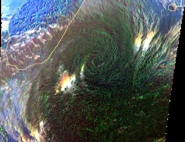Greenhouse Effect - Parasol Effect
Climate mechanisms
The vast majority of available energy on our planet’s surface comes from the Sun. Radiation from the sun covers a wide range of wavelengths, from ultraviolet to visible light to infrared. About one third of all energy coming from the Sun is sent back out into space (by simple reflexion or by diffusion in clouds or suspended particles in the atmosphere). This is called the parasol effect. Remaining energy is absorbed as heat either by the atmosphere or the surface of the Earth. The surface, after being heated by the Sun’s rays, emits infrared radiation back out into space.
![]()
Net radiation and anthropogenic disturbances
Estimated impact of the greenhouse and parasol effects on Earth’s energy balance.
Calculating a theoretical average temperature on Earth based on the amount of energy received from the Sun through our atmosphere gives a result of about -18°C. However data shows the actual average temperature, taking into account seasonal and geographical variations, is 15°C. The difference between these figures stems from the fact that the Earth’s infrared radiation isn’t entirely released into space. A large portion is captured by certain gases in the atmosphere, called greenhouse gases (carbon dioxide, water vapour, methane, nitrogen oxide, ozone, etc.); their molecules absorb the Earth’s infrared radiation and release it in every direction, thus heating the Earth. This natural greenhouse effect is necessary for life to develop. Clouds are very opaque to thermal infrared and also contribute to this phenomenon.
However, mankind’s efforts to develop and industrialise the economy tend to change the composition of our atmosphere by injecting large quantities of greenhouse gases. This process, called anthropogenic forcing, is responsible for a 0.5°C increase of the average surface temperature in the past few decades alone. Climate models calculate it represents about 2.8 W.m² since the mid-18th century, with little geographical variations.
On the other hand, the amount and concentration of particles in the atmosphere is also increasing, which contributes to the parasol effect and should help cool down the planet. Is this parasol effect enough to counteract a growing greenhouse effect? That is what scientists are currently trying to find out. And the best way to do so is to improve computer climate models to estimate how intensely and how quickly climate change is progressing all over our planet.
Imprecise net radiation calculations
Aerosol-induced radiative forcing is defined as the variation in Earth’s net radiation resulting from the presence of aerosols injected into the atmosphere by current human activity when compared to 1750. Today, this process is estimated to be weaker but comparable to greenhouse gases’ impact, uncertainties surrounding aerosols are much greater. Experts are still in the dark when it comes to indirect and semi-direct (via clouds) effects; as for direct radiative forcing, it is still difficult to quantify the impact of desert dust, the sources of which may have increased due to human activity. Furthermore, aerosol-induced radiative effects are often found to vary by dozens of W.m² depending on the season or the area, but the impact they have on the atmosphere’s dynamics has yet to be determined and modelled.
Thus scientists make use of missions such as Parasol to better understand physical and microphysical properties in clouds and aerosols in order to answer these questions. Do certain aerosols have a cooling or heating effect on a regional scale? What is the nature of these particles and where do they come from? Are clouds made up of water droplets or ice crystals? What are the shape, size and orientation of the particles making up these clouds? All these characteristics determine their radiative impact.
The scientific community has been preoccupied by these issues for the past 15 years or so, and space observation has been able to provide global and regular monitoring capabilities to supplement computer models. Several instruments, such as ScaRaB on Russian satellites or Polder on Japanese Adeos satellites, provide access to the global net radiation and atmospheric aerosol content data. Additional onsite observation campaigns are set up, including airborne missions. These combined efforts are necessary to quantify aerosol-induced radiative forcing and its impact on climate change.


